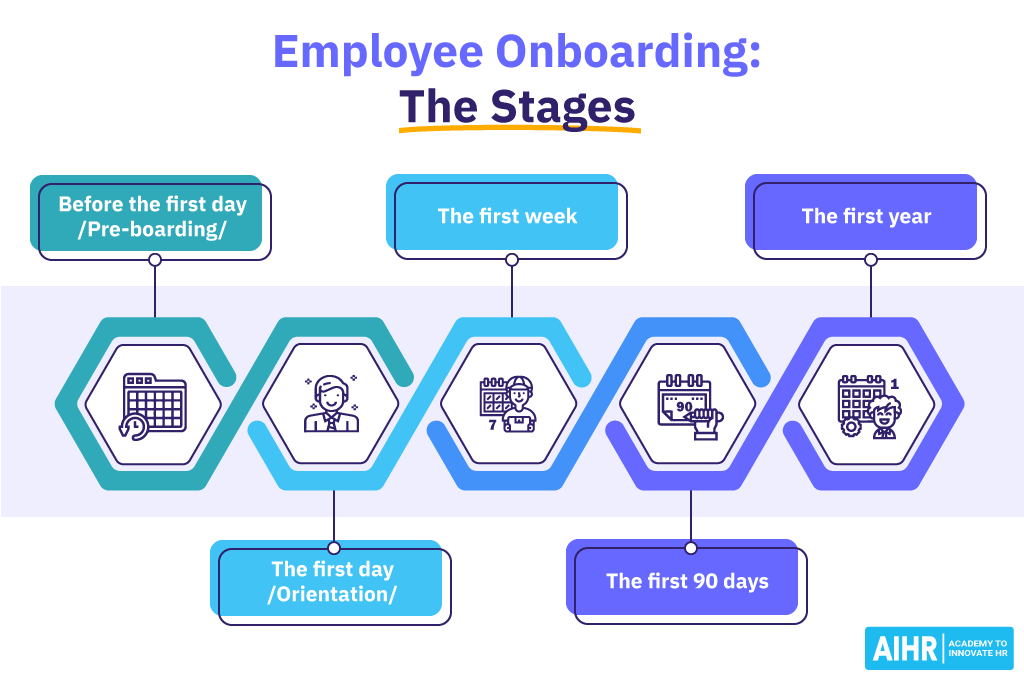Welcoming new employees to your organization with a well-structured onboarding plan is crucial for setting them up for success. An effective onboarding process not only helps new hires acclimate to their roles and responsibilities but also fosters engagement, retention, and productivity. In this comprehensive guide, we’ll outline the key steps and best practices for creating an onboarding plan that ensures a smooth transition for new employees and sets the stage for long-term success.
Onboarding Preparing Before Day One:
Before the new employee’s first day, it’s essential to lay the groundwork for a successful onboarding experience. This preparation stage involves several key tasks:
Develop a detailed onboarding schedule outlining activities and milestones for the first week, month, and beyond. This schedule will serve as a roadmap for both the new employee and the onboarding team.
Gather necessary paperwork and resources, including employee handbooks, benefits information, and relevant training materials. Having these documents ready in advance will streamline the onboarding process and provide the new hire with essential information.
Set up the new hire’s workstation, including access to technology, software, and any specialized tools or equipment they may need to perform their job effectively. Ensuring that everything is in place before the employee arrives will demonstrate organizational readiness and professionalism.

Warm Welcome and Orientation:
The new employee’s first day sets the tone for their entire onboarding experience, so it’s crucial to make them feel welcome and valued from the moment they walk through the door. Here’s how to create a positive first impression:
Designate a point of contact or mentor to greet the new employee on their first day and provide a warm welcome. This person will serve as a friendly face and resource for any questions or concerns the new hire may have.
Conduct a comprehensive orientation session to introduce the company’s mission, values, culture, and organizational structure. This orientation will help the new employee understand the company’s overall direction and how their role fits into the bigger picture.
Schedule meetings with key stakeholders, team members, and department heads to facilitate networking and relationship-building. These introductions will help the new hire establish connections within the organization and feel like a valued member of the team from day one.
Role Clarity and Training:
Once the new employee has settled in, it’s time to provide them with the tools and resources they need to succeed in their role. This stage of the onboarding process focuses on role clarity and job-specific training:
Clearly define the new hire’s role, responsibilities, and performance expectations to set clear objectives and goals. Providing a detailed job description and performance metrics will help the employee understand what is expected of them and how their performance will be evaluated.
Provide job-specific training and resources to help the employee gain proficiency in their role and understand workflow processes. This training may include shadowing experienced team members, attending training sessions or workshops, and completing online courses or certifications.
Offer opportunities for skill development and continuous learning through workshops, online courses, and mentorship programs. Encouraging the new employee to expand their skills and knowledge will not only benefit them personally but also contribute to their long-term success within the organization.

Integration and Engagement:
As the new employee becomes more familiar with their role and responsibilities, it’s important to focus on integration and engagement to ensure they feel like a valued member of the team:
Encourage participation in team meetings, projects, and social events to foster a sense of belonging and collaboration. This involvement will help the new hire build relationships with colleagues and feel integrated into the team culture.
Assign a buddy or peer mentor to support the new employee’s integration into the team and provide ongoing guidance and feedback. Having a designated mentor will give the new hire a trusted resource for advice, support, and professional development.
Solicit feedback from the new hire regarding their onboarding experience and areas for improvement to refine the process for future hires. Actively seeking input from new employees demonstrates a commitment to continuous improvement and fosters a culture of open communication and transparency.

Ongoing Support and Follow-Up:
The onboarding process doesn’t end after the first week or month—it’s an ongoing journey that requires ongoing support and follow-up to ensure the new employee’s success:
Schedule regular check-ins with the new employee to assess progress, address any challenges or concerns, and provide additional support as needed. These check-ins can take the form of one-on-one meetings, performance reviews, or informal check-ins over coffee.
Review performance expectations and provide constructive feedback to help the employee succeed in their role. Offering regular feedback and recognition will motivate the new hire to continue performing at their best and contribute positively to the organization.
Continuously evaluate and refine the onboarding process based on feedback, changing business needs, and best practices in employee development. The onboarding process should be dynamic and adaptable, evolving over time to meet the needs of both the organization and its employees.
Conclusion:
A well-executed onboarding plan is essential for setting new employees up for success and fostering a positive employee experience. By following these key steps and best practices, organizations can ensure that new hires feel welcomed, supported, and equipped to make meaningful contributions from day one. Investing in a comprehensive onboarding program not only benefits individual employees but also strengthens the organization’s overall culture, morale, and productivity.


Leave a Reply